Creating your own mini indoor garden in a terrarium is a fun and easy way to bring the beauty of nature into your home. 🌱🌻
In this article, I will share with you 11 miniature houseplants that are perfect for terrariums.
🌞🏠These plants are small in size but big on color and texture, making them ideal for creating a vibrant and lush display in your terrarium. Whether you’re a beginner or experienced gardener, these plants are sure to thrive in the humidity and low light conditions of a terrarium.🌿🌸
Tillandsia Stricta
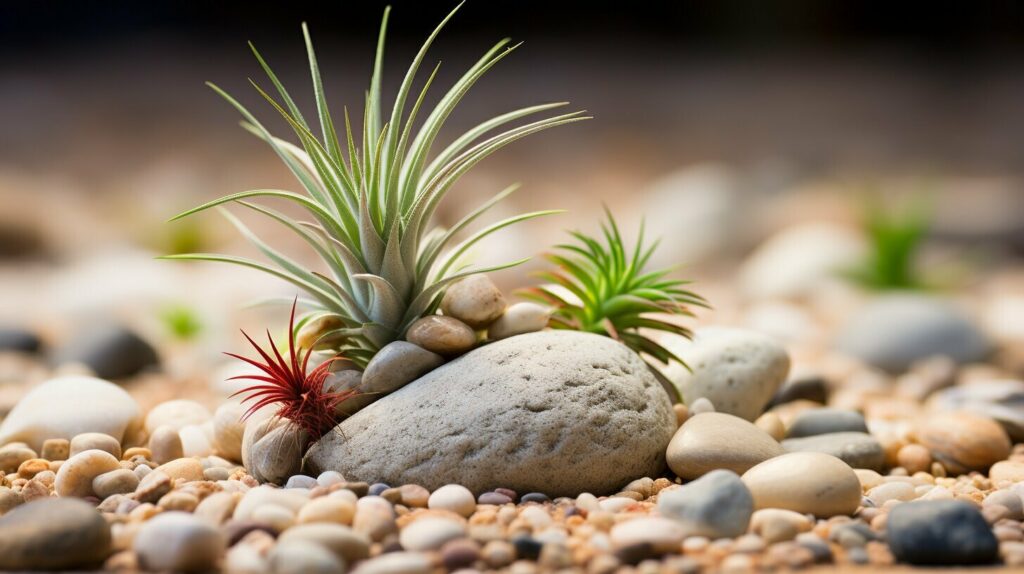
The Tillandsia Stricta, also known as an air plant, is a versatile terrarium plant that offers both color and texture. This unique plant doesn’t require soil and can be set among other plants in a terrarium or displayed on its own. Its small, compact size makes it a great choice for smaller terrariums, adding a touch of greenery without overcrowding the space.
The Tillandsia Stricta is known for its vibrant colors and interesting foliage. Depending on the variety, the leaves can range from shades of green to red, purple, or even silver. The leaves often have a slightly curly or wavy shape, adding to their visual appeal. With proper care, this air plant can grow up to 8 inches tall and wide, creating a lush and dynamic display in your terrarium.
Benefits of Tillandsia Stricta:
- Doesn’t require soil
- Versatile and compact size
- Comes in a variety of colors
- Thrives in low light and high humidity
- Easy to care for
Pilea Glauca ‘Aquamarine’

This low light terrarium plant boasts rounded, silvery-blue leaves with tiny speckles, adding both color and texture to your indoor garden. With its ability to stay small and low-growing, the Pilea Glauca ‘Aquamarine’ makes an excellent base for other plants in your terrarium. This plant can grow up to 12 inches tall and wide, creating a lush and vibrant display.
Why choose Pilea Glauca ‘Aquamarine’ for your terrarium?
- Thrives in low light conditions
- Requires high humidity
- Features rounded, silvery-blue leaves
- Provides a compact and colorful addition to your terrarium
With its visually appealing appearance and ability to thrive in low light and high humidity, the Pilea Glauca ‘Aquamarine’ is the perfect addition to your terrarium.
Ophiopogon Planiscapus ‘Nigrescens’
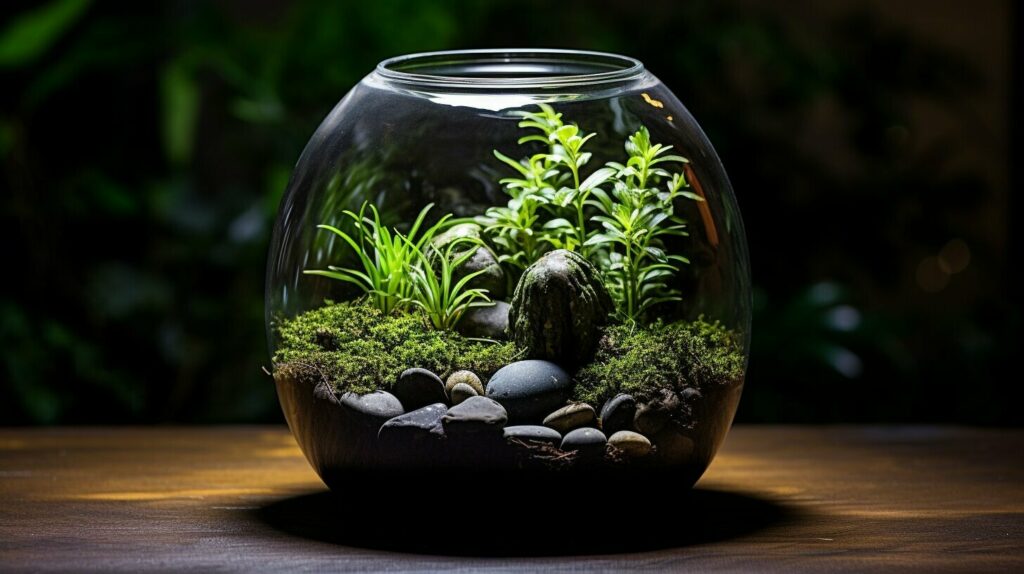
When it comes to adding a touch of drama to your terrarium, look no further than the Ophiopogon Planiscapus ‘Nigrescens’, also known as black mondo grass. This unique terrarium plant is commonly used as a groundcover in outdoor gardens but can also make a striking addition to your miniature indoor landscape. With its dark, strappy leaves, it adds a moody hue that contrasts beautifully with other plants in your terrarium. The Ophiopogon Planiscapus ‘Nigrescens’ creates a sense of depth and texture, turning your terrarium into a captivating display.
This terrarium plant is low-growing, making it suitable for small spaces. Its compact size allows it to fit seamlessly into any terrarium, whether it’s a closed or open-top design. The Ophiopogon Planiscapus ‘Nigrescens’ adds visual interest to your mini garden with its unique foliage color and shape. Its dark leaves create a striking contrast against the vibrant hues of other terrarium plants, making it a focal point of your indoor landscape.
Why Choose Ophiopogon Planiscapus ‘Nigrescens’?
- Moody hue: The black foliage of this plant brings a touch of drama and elegance to your terrarium.
- Unique texture: The strappy leaves of the Ophiopogon Planiscapus ‘Nigrescens’ create visual interest and add texture to your miniature garden.
- Low-maintenance: This plant is easy to care for and requires minimal attention, making it ideal for both beginner and experienced gardeners.
- Versatile: Whether you have a closed or open-top terrarium, this plant can thrive in various terrarium setups.
Golden Clubmoss

When it comes to creating a lush and vibrant terrarium, finding the perfect groundcover is essential. That’s where the Golden Clubmoss (Acorus Gramineus ‘Minimus Aureus’) comes in. This stunning terrarium plant adds a touch of golden beauty to your miniature indoor garden. With its grassy, golden foliage, the Golden Clubmoss stays compact in height but likes to spread, making it an excellent choice for filling in empty spaces in your terrarium.
Why Choose Golden Clubmoss?
- Beautiful golden foliage adds color and texture to your terrarium
- Compact growth fits well in smaller terrariums
- Ideal groundcover plant that fills in empty spaces
- Thrives in consistently moist soil and high humidity
- Can also be used as a groundcover in shade gardens in warmer zones
The Golden Clubmoss is a versatile plant that can adapt to different growing conditions. In a closed terrarium, it thrives in the high humidity and consistently moist soil. Its compact growth and spreading nature make it perfect for filling in empty spaces between larger plants, creating a lush and cohesive display.
Pilea Involucrata ‘Moon Valley’
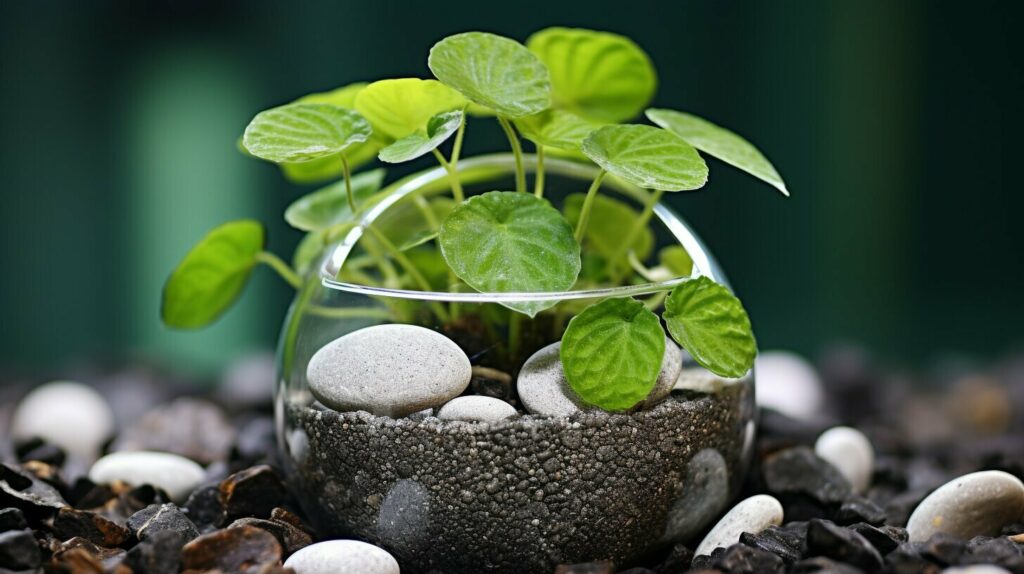
The Pilea Involucrata ‘Moon Valley’, also known as friendship plant, is a terrarium plant that brings a unique and textured look to your indoor garden. Its deeply textured leaves form craters and valleys, giving it a distinct appearance. The two-tone green and purplish-red leaves create a beautiful contrast, standing out among the all-green plants in your terrarium. And if you’re lucky, this plant may surprise you with delicate pink flowers, adding a touch of elegance to your mini landscape.
With its compact growth habit, the Pilea Involucrata ‘Moon Valley’ is perfect for smaller terrariums. It grows up to 12 inches tall and wide, making it an ideal choice for adding height and texture to your miniature indoor garden. This plant is low-maintenance and thrives in the high humidity of a closed terrarium. Simply provide it with consistent moisture, and it will reward you with its stunning foliage.
Why Choose Pilea Involucrata ‘Moon Valley’ for Your Terrarium?
- The textured craters and valleys of its leaves create an eye-catching display.
- The two-tone green and purplish-red leaves add color and contrast to your terrarium.
- This plant may surprise you with delicate pink flowers, adding a touch of elegance.
- Its compact growth makes it perfect for smaller terrariums.
- Thrives in the high humidity of a closed terrarium.
Asplenium Bulbiferum
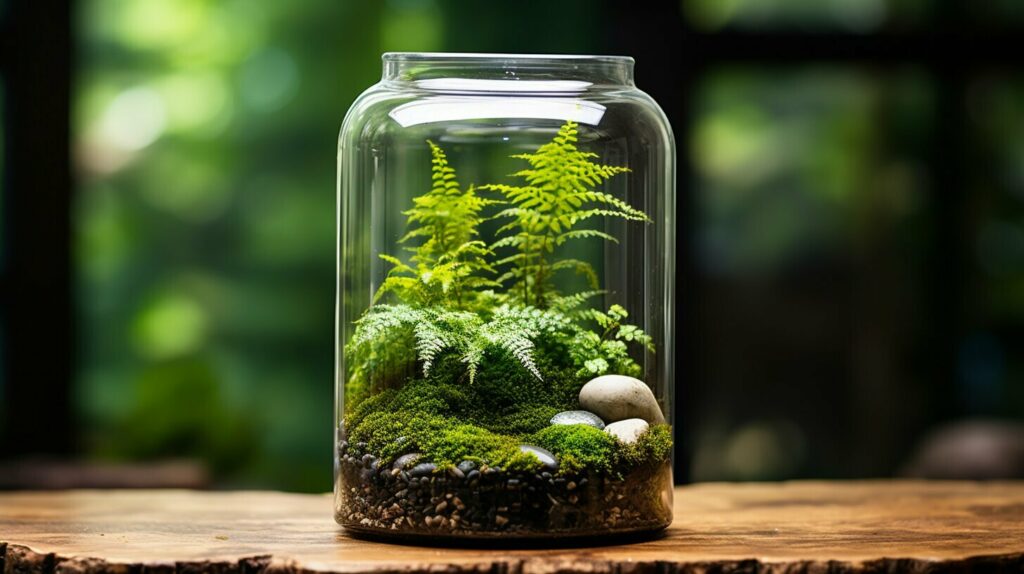
The Asplenium Bulbiferum, also known as mother fern, is a graceful and fine-textured terrarium plant that adds beauty and elegance to any indoor garden. With its arching fronds and delicate foliage, it creates a sense of tranquility and natural beauty.
This terrarium plant thrives in high humidity, making it ideal for enclosed terrariums where moisture levels can be maintained. Its fronds can grow up to 2 feet tall and 4 feet wide, adding a vertical element to your terrarium and creating a lush and vibrant display.
One unique feature of the Asplenium Bulbiferum is its ability to produce tiny plantlets on mature fronds. These plantlets can be delicately removed and replanted to create new ferns or replace the original plant if it outgrows your terrarium. This natural process of propagation allows you to expand your indoor garden and maintain a perfect balance within your terrarium.
Key Features of the Asplenium Bulbiferum:
- Graceful and fine-textured terrarium plant
- Arching fronds add a sense of elegance
- Thrives in high humidity
- Produces tiny plantlets for easy propagation
- Vertical growth adds depth and variety to your terrarium
Nerve Plant
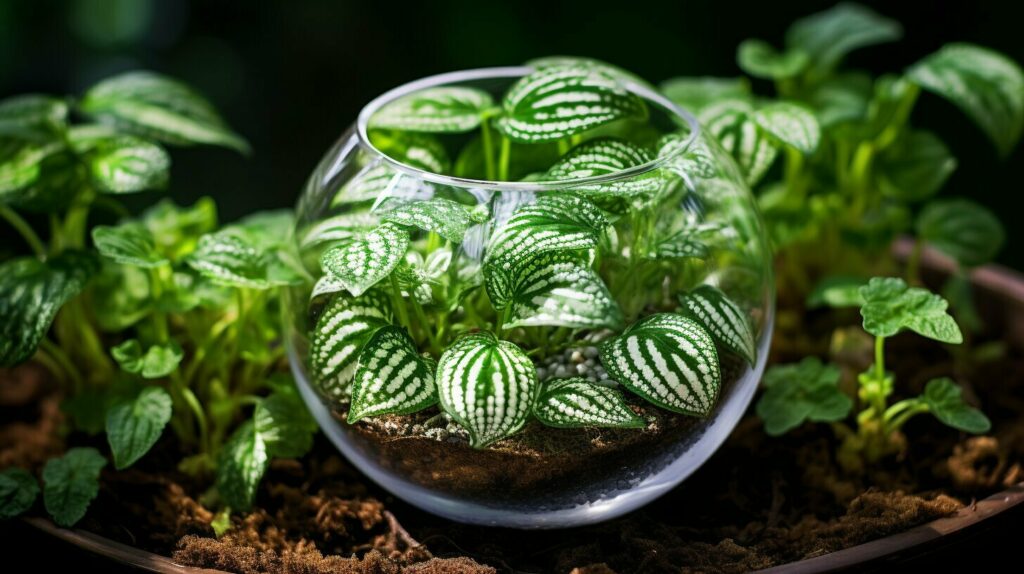
If you’re looking to add a pop of color and unique texture to your terrarium, look no further than the Fittonia Verschaffeltii var. Argyroneura, commonly known as the nerve plant. This tropical terrarium plant features leaves with a striking netlike pattern in shades of silvery white, burgundy, or pink. With its vibrant colors and intricate veins, the nerve plant is sure to catch your eye.
One of the great things about the nerve plant is its ability to thrive in the high humidity of a closed terrarium environment. This makes it an excellent choice for indoor gardening enthusiasts who want to create a lush and tropical display. The plant grows up to 12 inches tall and wide, allowing it to fill up space and add a burst of color to your terrarium.
Another advantage of the nerve plant is its ability to propagate easily.
If the plant starts to crowd other plants in your terrarium, simply trim it back and use the cuttings to start new plants. This makes it a versatile and low-maintenance option for terrarium enthusiasts of all skill levels. Just make sure to keep the soil consistently moist to provide the best growing conditions for the nerve plant.
Benefits of the Nerve Plant in Your Terrarium:
- Provides a burst of color with its vibrant netlike pattern leaves.
- Thrives in the high humidity of a closed terrarium.
- Easy to propagate by trimming back and using cuttings.
- Low-maintenance and suitable for beginners.
Peperomia Caperata
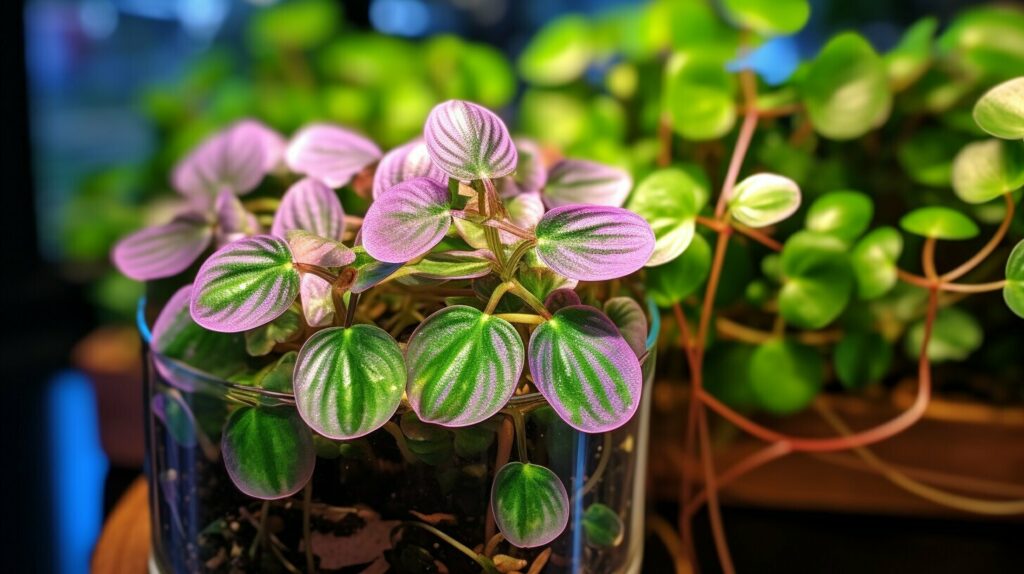
The Peperomia Caperata is a charming terrarium plant with heart-shaped leaves that feature textured wrinkles. Its unique foliage adds an intriguing and eye-catching element to your indoor garden. With its compact size and slow growth, this plant is perfect for small terrariums, adding a touch of sophistication and beauty.
One of the key factors that make the Peperomia Caperata a great choice for terrariums is its ability to thrive in high humidity. Terrariums create a humid environment that mimics the plant’s natural habitat, allowing it to flourish and grow. This plant appreciates consistent moisture, so misting regularly or using a humidifier can help maintain the ideal conditions.
The Peperomia Caperata grows up to 6 inches tall and wide, making it a compact and versatile addition to your terrarium. Its reddish stems add a pop of color, complementing the textured leaves. This plant is a great choice for both beginners and experienced gardeners looking to create a visually appealing and low-maintenance terrarium.
Key Features of Peperomia Caperata:
- Heart-shaped leaves with textured wrinkles
- Thrives in high humidity
- Compact size, grows up to 6 inches tall and wide
- Slow growth rate
- Perfect for small terrariums
Cryptanthus Bivittatus: A Colorful Starfish Plant for Your Terrarium

Are you looking for a unique and eye-catching terrarium plant? Look no further than Cryptanthus Bivittatus, also known as the starfish plant. This stunning plant belongs to the bromeliad family and is sure to add a pop of color and vibrancy to your indoor garden.
The starfish plant gets its name from its distinctive strap-like leaves that resemble the shape of a starfish. But what makes this plant truly captivating is its iridescent stripes that range from red to maroon, white, and deep green. These colors change with the intensity of light, creating a visually dynamic display in your terrarium.
With its compact size, growing up to 6 inches tall and wide, the starfish plant is a perfect choice for small terrariums. Its bold leaf colors and unique patterns make it an excellent centerpiece or focal point in your miniature indoor garden. Whether you’re a beginner or an experienced terrarium enthusiast, the starfish plant is sure to impress with its beauty and versatility.
Key Features of Cryptanthus Bivittatus:
- Belongs to the bromeliad family
- Iridescent stripes ranging from red to maroon, white, and deep green
- Compact size, growing up to 6 inches tall and wide
- Perfect for small terrariums
- Eye-catching centerpiece or focal point
Strawberry Begonia
If you’re looking for an eye-catching terrarium plant that stays small and adds a unique touch to your indoor garden, look no further than the Saxifraga Stolonifera, commonly known as the strawberry begonia. Despite its name, the strawberry begonia is not actually a begonia or related to strawberries. However, its leaves bear a striking resemblance to begonia foliage, making it a fascinating addition to any terrarium.
What makes the strawberry begonia truly special is its compact growth and runners. This plant stays small in size, making it a great choice for terrariums of any size. As it grows, it sends out runners just like strawberry plants, creating a lovely cascading effect that adds depth and visual interest to your terrarium. The runners can be trimmed or guided to create the desired shape, allowing you to customize the look of your miniature indoor garden.
The strawberry begonia thrives in a terrarium environment, where it benefits from the high humidity and low light conditions. It prefers consistently moist soil, so make sure to water it regularly and provide adequate drainage to prevent overwatering. With proper care, this plant will continue to thrive and bring a touch of elegance to your terrarium for years to come.
Arachniodes Simplicior ‘Variegata’
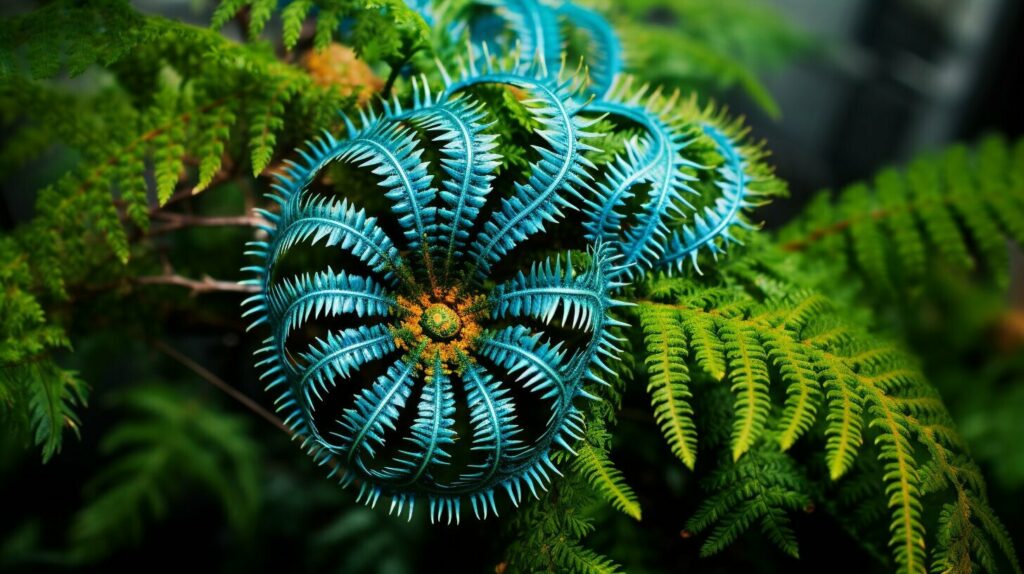
The Arachniodes Simplicior ‘Variegata’, also known as variegated spider fern, is an easy-care terrarium plant that adds beauty and texture to your indoor garden. This fern features glossy, green leaves adorned with a striking yellow band down the center, making it visually unique and eye-catching. The contrasting colors of the foliage create a vibrant display in your terrarium, adding a touch of elegance and charm.
With its compact growth habit, the variegated spider fern is an excellent choice for smaller terrariums. It can reach a height and width of up to 16 inches, allowing it to fill the space beautifully without overwhelming other plants. This fern thrives in the shade and is a perfect addition to a shade garden in Zones 6-9 if it outgrows your terrarium.
Key Features of Arachniodes Simplicior ‘Variegata’
- Glossy, green leaves with a vibrant yellow band
- Compact growth habit ideal for smaller terrariums
- Thrives in shade and high humidity
- Can be planted in a shade garden in Zones 6-9
Ficus Pumila: The Perfect Ground Cover for Your Terrarium
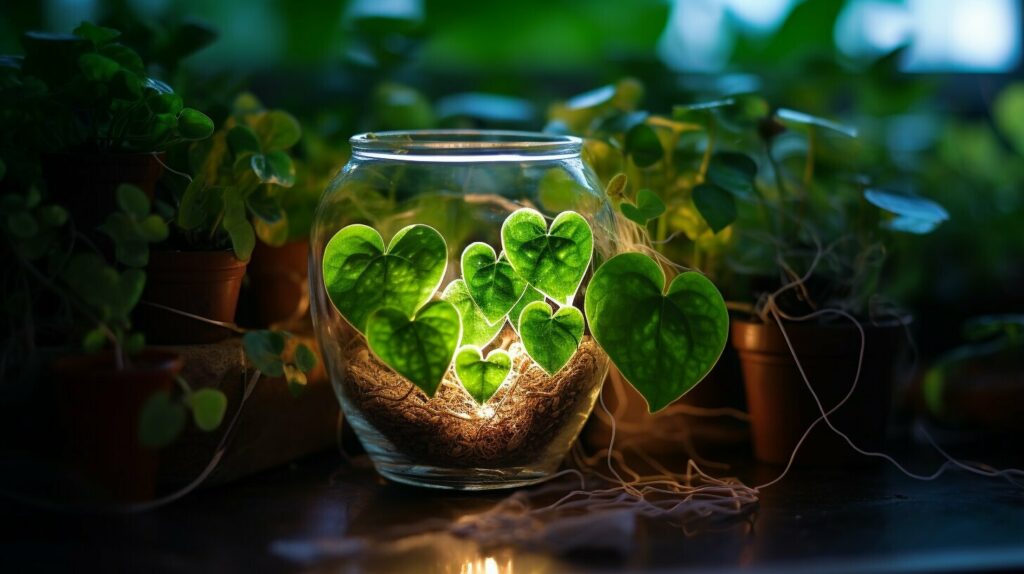
Looking for a versatile and visually appealing terrarium plant? Look no further than Ficus Pumila, also known as creeping fig. This tropical beauty is the ideal ground cover for your miniature indoor garden. Native to the jungles of East Asia, Ficus Pumila is well-suited for the high humidity and low light conditions of a closed terrarium.
With its small, heart-shaped leaves and vigorous growth, Ficus Pumila creates a naturalistic feel and adds depth to your terrarium. Its trailing vines can be trained to climb up walls or cascade over rocks, creating a lush and vibrant display. The ‘Minima’ variety, in particular, is perfect for smaller containers, adding a touch of greenery without overpowering the space.
Whether you’re a beginner or an experienced terrarium enthusiast, Ficus Pumila is an excellent choice. Its low maintenance requirements make it easy to care for, and its rapid growth ensures that your terrarium will quickly fill in. Plus, the creeping fig’s ability to form a dense mat of foliage makes it a great option for preventing soil erosion and covering unsightly areas in your terrarium.
Why Choose Ficus Pumila as your Terrarium Ground Cover?
- Thrives in high humidity and low light conditions
- Trailing vines can be trained to climb or cascade
- Creates a naturalistic feel in your terrarium
- ‘Minima’ variety is perfect for smaller containers
- Low maintenance and rapid growth
- Prevents soil erosion and covers unsightly areas
Macodes Petola
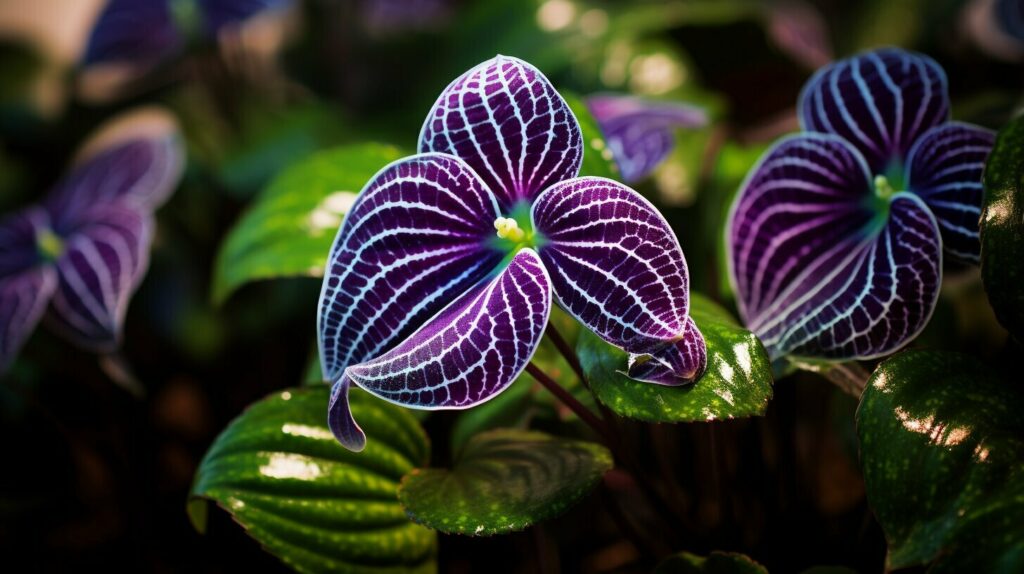
If you’re looking for a terrarium centerpiece that will truly make a statement, look no further than the Macodes Petola, also known as the lightning jewel orchid. This stunning terrarium plant boasts exotic foliage with a signature electric gold pattern that runs the full length of its leaves. Native to the lush jungles of Southeast Asia, the Macodes Petola is sure to add a touch of the extraordinary to your indoor garden.
With its bold colors and unique leaf patterns, the Macodes Petola is best showcased as the centerpiece in the foreground of a tropical terrarium. Its eye-catching foliage will instantly draw attention and become the focal point of your miniature indoor garden. Whether you’re a beginner or an experienced terrarium enthusiast, the lightning jewel orchid will bring a sense of wonder and beauty to your home.
Exotic Foliage
- The Macodes Petola features exotic foliage with a striking electric gold pattern.
- The leaves are elongated and have a smooth, glossy texture.
- This terrarium plant adds a touch of the extraordinary to your indoor garden.
Terrarium Centerpiece
- The Macodes Petola is best displayed as the centerpiece in the foreground of a tropical terrarium.
- Its bold colors and unique leaf patterns instantly catch the eye and become the focal point of your miniature indoor garden.
- Whether you’re a beginner or an experienced terrarium enthusiast, this plant will bring a sense of wonder and beauty to your home.
With its exotic foliage and striking appearance, the Macodes Petola is a must-have for any terrarium enthusiast. Add a touch of the extraordinary to your indoor garden and let the lightning jewel orchid become the centerpiece that steals the show.
Microsorum Musifolium
The Microsorum Musifolium, also known as crocodile fern, is a terrarium plant that adds a touch of the exotic to your indoor garden. With its scaly green leaves that resemble a crocodile’s back, this fern brings a unique texture and appearance to your terrarium. Its wild growth makes it a great choice for larger terrariums, where it can showcase its full potential.
This crocodile fern thrives in high humidity, making it perfect for the controlled environment of a terrarium. Its ability to adapt to varying light levels allows you to place it in different spots within your terrarium, creating a dynamic display. The scaly leaves not only add visual interest but also provide an intriguing texture that sets this fern apart.
Whether you’re a beginner or an experienced terrarium enthusiast, the Microsorum Musifolium is a must-have plant for your collection. Its striking appearance and easy-care nature make it a standout choice. Add this crocodile fern to your terrarium and enjoy the beauty of its scaly green leaves and wild growth.
FAQ
Are these miniature houseplants suitable for beginners?
Yes, these plants are easy to care for and thrive in the humidity and low light conditions of a terrarium, making them perfect for beginners.
Do these plants require soil in a terrarium?
No, some of the plants, like the Tillandsia Stricta, don’t require soil and can be displayed in a soil-less terrarium.
What size do these plants grow to?
The size varies depending on the plant, but most of them stay compact and petite, ranging from 4 inches to 12 inches tall and wide.
Can these plants be used as groundcover in a terrarium?
Yes, some plants like the Pilea Glauca ‘Aquamarine’ and Ficus Pumila are perfect for groundcover in a terrarium, creating a naturalistic feel.
Do these plants require high humidity?
Yes, most of these plants thrive in high humidity, which is typically found in a closed terrarium. However, it’s important to monitor and maintain the humidity levels in your terrarium.
Can these plants be used in shade gardens outside of a terrarium?
Yes, some plants like the Acorus Gramineus ‘Minimus Aureus’ and Arachniodes Simplicior ‘Variegata’ can also be used as groundcover or shade garden plants in Zones 6-9.
Do these plants require a lot of light?
No, most of these plants are low light tolerant and can thrive in the low light conditions of a terrarium. However, it’s still important to provide some indirect light to ensure their health and growth.
Can these plants be propagated or divided?
Yes, some plants like the Fittonia Verschaffeltii var. Argyroneura and Peperomia Caperata can be easily propagated through stem cuttings and used to start new plants.
How often should these plants be watered?
These plants generally prefer consistently moist soil, but overwatering should be avoided. It’s best to check the moisture level of the soil and water accordingly to prevent waterlogging.
Can these plants be grown in open terrariums?
While these plants can thrive in a closed terrarium, they can also be grown in an open terrarium as long as the humidity and light conditions are suitable for their needs.
Can these plants be grown together in the same terrarium?
Yes, these plants can be grown together in the same terrarium, as long as their growth habits and light requirements are compatible. It’s important to consider the size and spread of each plant to prevent overcrowding.





